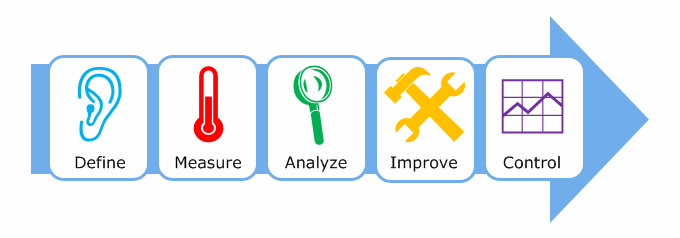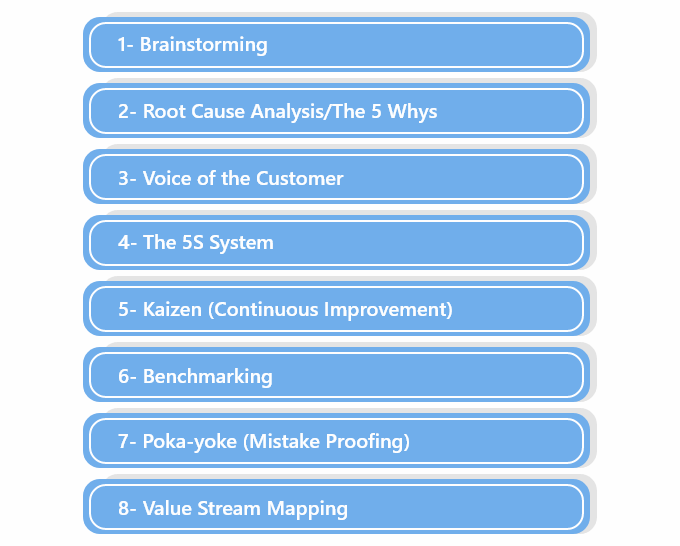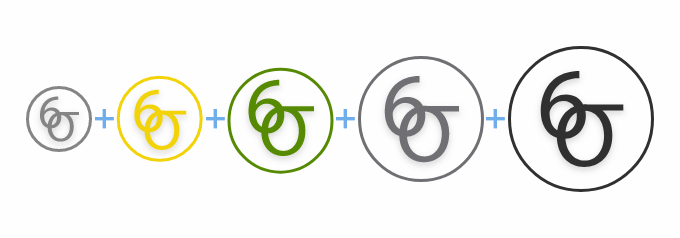Six Sigma is a process that makes use of use of statistics as well as data analytics to study and eliminate defects or errors. The goal is to reduce time-to-market while decreasing manufacturing defects to less than 3.4 per million units or incidents.
OR,
Six Sigma is a method that provides companies with instruments to enhance their abilities in managing their business. This improvement in performance and reducing process variability allows you to lower the rate of defects and boost employee morale and the quality of products and services, all of which contribute to higher profit levels.
Six Sigma is a set of management tools and methods designed to enhance the efficiency of the process by decreasing the chance of errors. Six Sigma is a method that relies on data and employs a statistical method to eliminate errors, defect reduction, and profit improvement.
Digital transformation is now the buzzword of the decade. The latest techniques and technologies are assisting the journey of change for businesses large and small in their quest to grab more business in a highly competitive and fast-paced market. But is it enough to ease the transition process? Can a single technology implementation eliminate a bottleneck in the production process or help investigate a design flaw? While digital transformation can accelerate the growth of a business, it must be accompanied by the management techniques of Quality control and business change.
In tune with the latest market trends and procedures in tune with new markets and processes, keeping up with new processes and markets, the American company Motorola came up with a fresh concept of quality management in the year 1986. Through the years, it has been refined to become a well-established theorem and method that aims to transform business by defining a clear method. The final item has been dubbed Six Sigma. In this article, we will go over the following subjects in depth:
- The five fundamental elements of six-sigma
- The six-sigma approach
- The six sigma method in business transform
- Top six sigma techniques
- Top 7 six sigma tools
- Six sigma levels
- Six sigma certification levels
- Many career options and aspects of salary
- Top six sigma learning resources
The etymology derives from the Greek symbol "sigma" or "s," the term used in statistical analysis to measure the deviation of a process from the mean of the process or goal. "Six Sigma" comes from the bell curve used in statistics, where one Sigma is the single standard deviation from the mean. If the process is characterized by six Sigmas, three higher and three lower than the average, the defect rate is defined as "extremely low."
The greater your standard deviation is, the wider the variance of values encountered. Thus, the processes where the mean is at least 6s from the nearest specifications limit are targeted toward Six Sigma.
The 5 Key Principles of Six Sigma
The idea behind Six Sigma has a simple objective - to provide near-perfect products and services that help businesses transform to ensure client satisfaction (CX).
Six Sigma has its base on five key principles:
Focus on the Customer
It is founded on the common notion that the "customer is the king." The main aim is to give the greatest value to the customers. A business must understand its client's needs and what triggers sales or loyalty. This means establishing quality standards based on the market or customer's requirements.
Measure the Value Stream and Find Your Problem
The steps of the process are to identify the areas that are prone to waste. Find out the particular problem that needs to be resolved or changed. Establish clear objectives for data collection, including the data to be monitored, the motive for collecting the data and the expected insights, ensuring accurate measurements, and setting up a uniform data collection process. Determine if the information is aiding in achieving the objectives and if the data requires to be refined. Find out the cause of the issue. Ask questions and determine the root of the issue.
Get Rid of the Junk
When the issue is discovered Once the issue is identified, you can make adjustments to reduce any variation and thus eliminate the defects. Take out the parts of the process that don't contribute to the value of the customer. If the value flow does not identify the issue's root, the tools can be used to identify problems and outliers. Streamline's function is to improve high-quality control and effectiveness. By eliminating the junk mentioned above and bottlenecks are eliminated.
Keep the Ball Rolling
Engage all people involved. Implement a structured process, so your team members contribute and share their diverse expertise in problem-solving.
Six Sigma processes can significantly impact an organization, so the team needs to know the fundamentals and methods employed. This is why specialized education and expertise are essential to decrease the chances of redesign or project failures and ensure that the process operates efficiently.
Ensure a Flexible and Responsive Ecosystem
The core of Six Sigma is business transformation and transformation. When an inefficient or flawed procedure has eliminated the need for changes in the work method and approach of employees, a strong culture of flexibility and adaptability to changes in processes can facilitate smooth implementation. The individuals and the departments involved must adjust to the changing environment easily to allow for these procedures should be designed to be able to quickly and seamlessly adopt. With its eyes on the numbers, which examines the bottom line frequently and tweaks its processes when needed, the company will achieve a competitive advantage.
The Six Sigma Methodology
The two most popular Six Sigma methodologies are DMAIC and DMADV. Each methodology has its own set of suggested methods to help businesses transform.
DMAIC is a method that uses data to improve the quality of existing products or services to achieve greater satisfaction with the customer. The acronym describes phases D define, M Measure, Analyse, I Improve, and C – Control. DMAIC is used for the production of a product or the delivery of a service.
DMADV is part of the Design for Six Sigma (DFSS) method used to create or redesign different production processes of products or services. Its five stages include D Define, M – Measure, D - Design, Define, M - Measure Analyze, D - Define, D - Design, and V Validate. DMADV is used when current methods do not meet the customer's needs, even after optimization or when it is necessary to design new methods. The DMADV process is conducted in the hands of Six Sigma Green Belts and Six Sigma Black Belts and is under the supervision of Six Sigma Master Black Belts. The belts will be discussed later.
The two methods can be used in various situations in the business world, and individuals who want to learn these techniques and their application scenarios are advised to enrol in an online certificate program that experts teach in the field.
The Six Sigma Process of Business Transformation
While Six Sigma uses various methods to identify deviations and resolve problems, the DMAIC method is the preferred method used for Six Sigma practitioners. Six Sigma uses a data-driven management approach to optimize and improve business process efficiency. The framework's foundation is focused on the customer and extensive utilization of statistics and data to the end.
The Six Sigma Process of the DMAIC method is comprised of Five Phases:

Every one of these phases in transformation includes a series of steps:
1-DEFINE
The Six Sigma process begins with a customer-centric approach.
First Step: The business issue is determined from the client's viewpoint.
Second Step: The goals are defined. What goals do you wish to accomplish? What are the tools you'll need to meet the objectives?
Third Step: Map out the procedure. Make sure that you have the approval of your stakeholders. You're on the right path.
2-MEASURE
The second phase focuses on metrics, as well as the tools that are used for assessment. What can you do to enhance your performance? How do you measure this?
First Step: Determine your issue using numbers or with information.
Second Step: Define performance yardstick. Set the limit for "Y. "
Third Step: Examine the measurement system that will be employed. Does it aid in achieving your goal?
3-ANALYZE
The 3rd phase studies the process to determine the factors that influence it.
First Step: Consider if the process is effective and efficient. Does the method help you achieve the goals you want to achieve?
Second Step: Measure your goals in terms of numbers. For example, reduce the number of defective products by 20 percent.
Third Step: Determine differences with historical data.
4-IMPROVE
This method examines how changes to "X" impact "Y." This is the time to determine how you can enhance the process's implementation.
First Step: Consider potential causes. Examine those "X" variables identified in Process III influence "Y. "
Second Step: Identify connections among the various variables.
Third Step: Determine process tolerance, defined as the exact values certain variables may have and remain within acceptable limits, for example, the quality of any product. What boundaries must X cross to ensure that Y is within the guidelines? What operational conditions could affect the final result? The process tolerances are made with tools like robust optimization and validation sets.
5-CONTROL
In this phase, you decide if your design improvements are durable and if the performance goal you identified in the previous phase has been effectively implemented.
First step: Verify the measurement system that will be employed.
Second Step: Establish process capability. Does the objective being met? For example, can the aim of reducing defective items to 20 percent be accomplished?
Third Step: You can implement the process after completing the previous step.
Are you interested in learning Lean Six Sigma and its significance? Look over this Lean Six Sigma Green Belt Certification course overview!
Six Sigma Techniques
Six Sigma methodology also uses the combination of data analysis and statistical tools, such as design and process mapping, as well as tested quantitative and qualitative methods to produce the desired result.

Brainstorming
Brainstorming is the primary process of any problem-solving approach and is frequently used during"the "improve" phase of the DMAIC method. It is an essential step before anyone can begin using any tool. Brainstorming involves bouncing ideas around and inventing new approaches to tackling the problem by engaging in intense group discussions that are freewheeling. Facilitators, usually the leader of Black Belt or Green Belt, moderate the open sessions within a group of people.
Root Cause Analysis/The 5 Whys
This technique can help identify the root of the issues under discussion and is employed during the "analyze" phase of the DMAIC cycle.
The "why" is asked repeatedly in the five whys method, eventually leading to the main problem. While "five" is a rule of thumb, the real number of questions could be higher or lower depending on the need for clarity.
Voice of the Customer
This process is utilized to collect the "voice of the customer" or customer feedback through either internal or external methods. The goal is to provide customers with the most effective quality products or services. It identifies the evolving needs of the client using direct and indirect techniques. Voice of the customer method is employed in the "define stage of the DMAIC method typically to define the issue that needs to be solved.
The 5S System
The basis of this technique is in the Japanese concept of workplace energy. It is the 5S System is aimed at getting rid of bottlenecks and waste caused by inefficient equipment, tools, or other resources at the workplace. The five steps comprise Seiri (Sort), Seiton (Set in the Order), Seiso (Shine), Seiketsu (Standardize), and Shitsuke (Sustain ).
Kaizen (Continuous Improvement)
The Kaizen method is highly effective and creates a continuous engine of business improvement. It involves constantly monitoring, identifying, and implementing improvements. This is an especially useful technique for manufacturing. Continuous improvements and collective efforts decrease the waste produced and quickly change when the tiniest inefficiency is noticed.
Benchmarking
Benchmarking is a method that uses a benchmark of measurement. It involves comparing the performance of other companies to get an objective assessment of the current circumstances. The process of benchmarking can involve comparing the most important processes or units within a company (internal benchmarking) or comparing similar functional areas or work areas with the industry's top performers (functional benchmarking), or the comparison of similar products or services against those offered by rivals (competitive benchmarking). ).
Poka-yoke (Mistake Proofing)
The term "poka-yoke" originates from the Japanese expression that means "to avoid errors," and is a means of preventing the possibility of errors from happening. With the poka-yoke process, employees identify and eliminate inefficiencies and human mistakes when manufacturing.
Value Stream Mapping
The value stream mapping method tracks the movement of information and materials to plan a new project. The goal is to eliminate waste or inefficiencies within the value stream and to create less consuming processes. It provides seven distinct kinds of waste and three kinds of operations to remove waste.
The Six Sigma Tools
- Cause and Effect Analysis
- Flow Chart
- Pareto Chart
- Histogram
- Check Sheet
- Scatter Plot
- Control Chart
Six Sigma Belts Levels
Six Sigma belt levels conform to specific training requirements, education requirements, and job standards and are eligible.

White Belt
It is the most basic stage, which includes:
- Any newcomer is welcome to join.
- People collaborate with teams to solve problems.
- The student is expected to grasp the basic Six Sigma concepts.
Yellow Belt
Here is you are the person who:
- Participates as a team member on the project.
- Reviews process improvements.
- Get a better understanding of the different methodologies, as well as DMAIC.
Green Level
The level at which HTML0 is proficient must meet the following criteria:
- Three years minimum of full-time work.
- Learn the methods and tools that are employed to solve problems.
- Practical experience with projects that involve some form of business process transformation.
- Guidelines on Black Belt projects in data collection and analysis.
- Lead Green Belt projects or teams.
Black Level
This level comprises this:
- Three years minimum of full-time work
- Experience in the essential knowledge field
- Achievement of the minimum of at least two Six Sigma projects
- Demonstrating skills in using multivariate metrics in diverse business settings for change.
- Leading diverse teams in problem-solving projects.
- Training and coaching for project teams.
Master Black Belt
To be able to reach this level, candidates must:
- You must have a Black Belt certification
- You must have a minimum of five full years' work or proof that you have completed a minimum of 10 Six Sigma projects.
- For example, a proof-of-concept portfolio of work with particular requirements, such as those listed here.
- I have been trained and coached in Black Belts and Green Belts.
- Create important strategies and metrics.
- I have worked as an organizational Six Sigma technologist and internal business transformation consultant.
The Six Sigma Certification Levels
Six Sigma certification is very similar to the System of certification that is used in martial arts, where the wannabe Six Sigma professional begins with the White Belt and then works until he can become the leader of the pack by acquiring a master Black Belt; or taking an integrated certification provided by certain institutions.
What are the Six Sigma Career Choices and Salary Prospects?
Six Sigma is a great opportunity to ascend the ladder of success with awesome job titles and match the salary expectations. Companies that frequently hire candidates for Sigma Six positions include 3M, Abbott Laboratories, General Electric, The Hershey Company, IBM, Honeywell, Newell Rubbermaid, Siemens, and Wells Fargo.
Six Sigma professionals have many career options: manufacturing engineers, compliance engineers, and operating system experts.
In addition, there are job opportunities that include the following names, though the exact terminology can differ from the company's perspective:
- Six Sigma Analyst
- Six Sigma Black Belt
- Six Sigma Consultant
- Director of Operational Excellence
- Functional Project Lead
- Senior Project Manager
- Six Sigma Projects Manager
- Business Process Manager
- Lead Analyst/Project Manager
Pay scales are also important; as per Glassdoor, an employee who is Six Sigma Green Belt certified will earn an average pay of $68,840.
Six Sigma Learning Resources
If you're a recent graduate from any discipline, engineering discipline, or MBA professional, If you're looking to boost your career opportunities and increase your earnings, be sure to obtain a certification in Six Sigma classes. Start with a Green Belt and climb towards a Master Black belt to command your pay. Suppose you are a newbie beginning to learn Six Sigma principles by enrolling in the program offered by IMC Institute's Lean Six Sigma Green Belt certification program. Then, take advantage of higher levels of certification when you get work and project experience.





